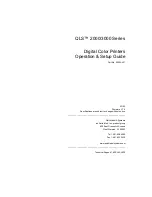
REV.-A
2.1 OVERVIEW OF PRINTER
{
MECHANISM OPERATION
This section describes the printer mechanism of the
printer unit and explains how the printer works.
has a printer mechanism that features a 24-pin
dot
for serial printing. There are four
main parts to the printer mechanism: 1) the
mechanism, 2) the carriage movement mechanism, 3) the
paper advance mechanism, and 4) the ribbon advance mechanism. Each of these is described below.
2.1.1
Mechanism
The
mechanism consists of the
itself, the ink ribbon, and the platen. The
24
wires in a zigzag arrangement in two rows of 12. A drive coil is provided for each of these wires to make the wires
move in and out of the
and print dots independently of each other. The basic way that the wires are driven
is described in the four steps below.
1.
2.
3.
4.
The control circuit outputs the drive signal to the
drive circuit. This changes the
drive
voltage, and current flows through the corresponding
coil. The coil acts as a solenoid and generates
a magnetic force.
This induced force causes the plate to approach the coil
and the associated dot wire is rapidly ejected to
impact on the platen.
The dot wire presses the ink ribbon up against the paper as it hits the platen, and in this way prints a dot on
the paper.
As soon as the current through the coil is switched off, the force induced in the
rod stops. The plate then
returns to its original
position before the coil was energized) through the action “of the
spring.
After the dot wire hits the platen, the rebounding force of hitting the platen works together with the wire return
spring to pull the wire back to its original position in relation to the plate.
PLATEN
Oot
Wire
RIBBON MASK
Spring
\
\
\
/
Ribbon
/
Plate Spring
Figure 2-1. How the
Works
Figure
2-1
shows the action of the printer mechanism when a single dot is printed.
The
tends to heat up
period of
printing. To minimize the possibility of the dot wire drive
coils overheating within the
and any loss of performance, the head is equipped with a thermistor that
detects the head temperature. When this thermistor detects changes intheprinthead temperature,
changes. This signal change is read by the control circuit for feedback
2-1
















































